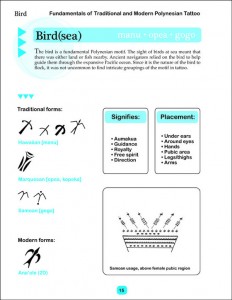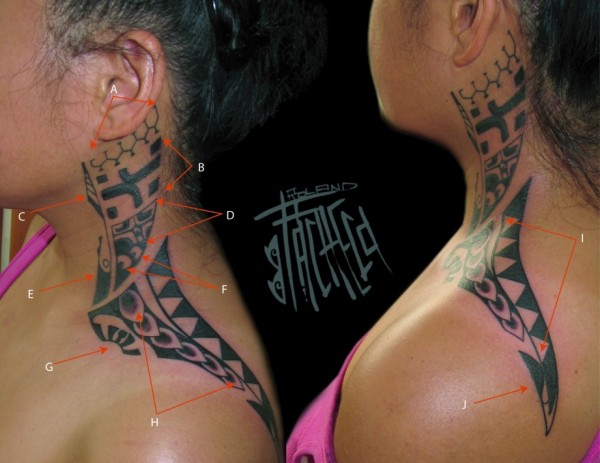I’ve always been really interested in the history of tattoos. I’m a bit inked, but have plenty of canvas left I want to fill on my travels. While I have a good understanding of modern and contemporary tattoos in western culture, and quite a bit about Japanese irezumi, I know very little about Polynesian tattoo’s. Now, lets get it straight that tattoos have been found everywhere throughout the world, from all periods of time. Many leathery mummies found in across the globe in various climes have been noted to have ornamental markings in their skin. The famous warrior Picts were quite decorated as well!
But even the word “tattoo” comes from the sound that is made via the traditional tattooing process by the people of Polynesia. This act (potentially seen as somewhat barbaric) was adopted by seafairing explorers and sailers between the 16th and 18th century. It became a mark of honor, a badge of where you’d been, set you apart from the crowd, and fulfilled a base instinct. So, why didn’t I know much about this traditional tattooing?
I’d say it was because the techniques, styles, and meanings have changed and evolved all over the world. Especially in the “fuck you” mentality melting pot I (lovingly) call the USA. There is so many different styles and motifs and the arts are evolving at a rapid pace! Things I saw pop-up ten years ago as fresh ideas are now staple pieces requested by enthusists everywhere. And these arts have been evolving so fast that no one has thought to chonicle the origins.
Until you meet Roland Pacheco, a 6th generation Polynesian and professional tattoo artist. He has been doing tattoos for years from the big island of Hawai’i (heh, that might be a redundant name). He is well versed in the different styles of tattoo design, but has a special interest in Polynesian. Such an interest, that he created a Polynesian tattoo reference guide. But this was mostly reference art for other tattooists, with some definitions. A good start, but it didn’t seem to satiate him.
His new goal is to publish a book that not only showcases these peices of art, but breaks down their meanings, history, and points of origin. He hopes to keep the tales and culture from being lost to progress, and document it now before it is too late. The book is untitled so far, but “The Fundamentals of Traditional and Modern Polynesian Tattoo” isn’t a bad guess.
And as I stated above, tattooing is evolving as fast as art and technology combined. The growing social acceptance of tattoos in the world is allowing more people to become involved with this art. While progress isn’t a bad thing, the form is changing so quickly/adapting to the popular trends and fashions that the old styles could die out. It took decades to decode Mayan and Aztecian writing, and the reference material was set in stone. Imagine the difficulty of trying to figure out what all of these strange-sharp monochrome and geometric designs mean when nothing is left to study but a bit of leathery skin rotting in a coffin.
Maybe that is somewhat of an exageration. And of course I have my design preferences. I’m not a fan of getting what everyone else has, poor work, or meaningless eyecandy. Hell, it is going to be on my body forever I don’t want to regret it. And what is terrible is that the majority of “tribal” (in quotes for a reason) tattoos I see are just… generic flash crap. While I’m not opposed to flash, I am opposed to the dullification and white-washing brought on by the surgence of popularity of these generic tattoos. These examples have lost their meaning and were just “cool” or “badass”. In my oppinion people getting these flash tribal are no smarter than the guy who picks out the word “Awesome” from a set of Chinese characters but actually gets “Spicy Curry Chicken”.
This needs to be completed. You can see examples of his work describing and explaining the art, meaning, stories, and cultural significance at his blog. Below is an excerpt of his blog, showcasing not on the art but the extreme mesh of story telling and meaning between each symbol.
Just finished this piece today. She wanted something that spoke of her family and ancestors. This is also a protection piece for her as well. The breakdown is as follows:
A- Aniata/ Halawai= The horizon where the sea and clouds meet, heaven, the reflection of the moon on the water. This symbol is ornamental and meant to be placed under ear lobes or any round body part. It was often placed on the buttocks (with ie vau and mata hoata) as a sign of defiance.
B- Hope Vehine= The symbol of the divine Siamese twins of tattoo, a symbol of power that invokes the power of the twins, also when placed on a female represents Kea, the turtle.
C- Lau Niu= Palm fronds, signifying higher status.
D- Mata Hoata= The face of divinity. meant to protect the wearer by ‘weeing’ danger or threats that the wearer may not see.
E- Koru= Fernhead, Maori symbol for everlasting life, cycle of life and new beginnings.
F- Poka’a= Marquesan symbols which represent strength. They add power to the wearer as well as the tattoo.
G- Etua= This particular tiki represents her son.
H- Hulu Pueo= Owl feathers. Her air aumakua is the owl. Each feather (6) represents the members of her immediate family.
I- Niho Mano= Shark teeth. Her water (ocean) aumakua is the shark. Each tooth (6) represents the members of her immediate family.
J- Hope Vehine= the placement of this symbol closes off the tattoo, fortifying it and adding protection to the symbols in the tattoo.
I sincerely hope this gets funded, and if not that Roland will continue to work on it over time!! I’ve let my tattooist know about it so more people can become educated on these wonderful pieces of culture, and they can be learned about by generations to come. Hopefully others recognize the importance of works like this.













